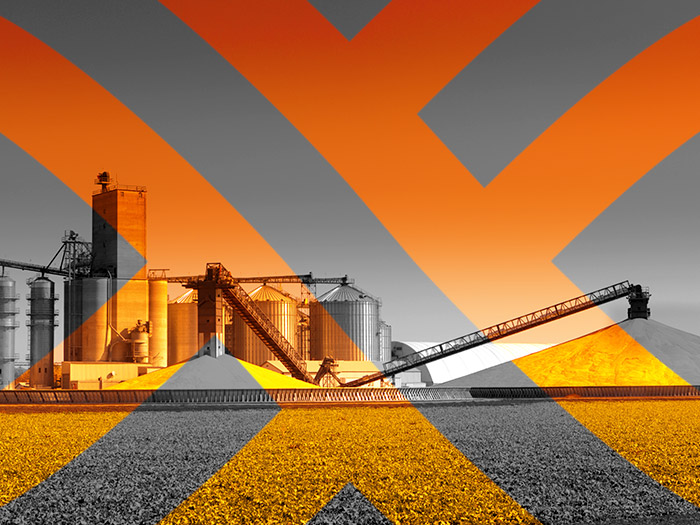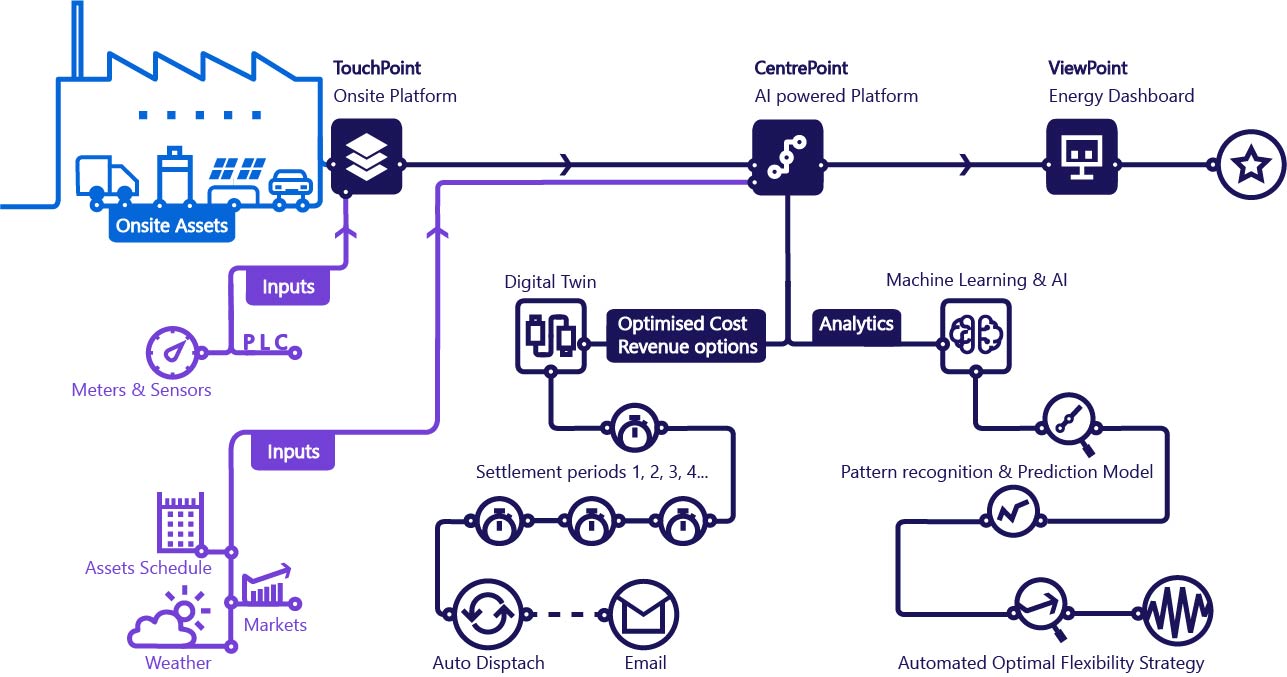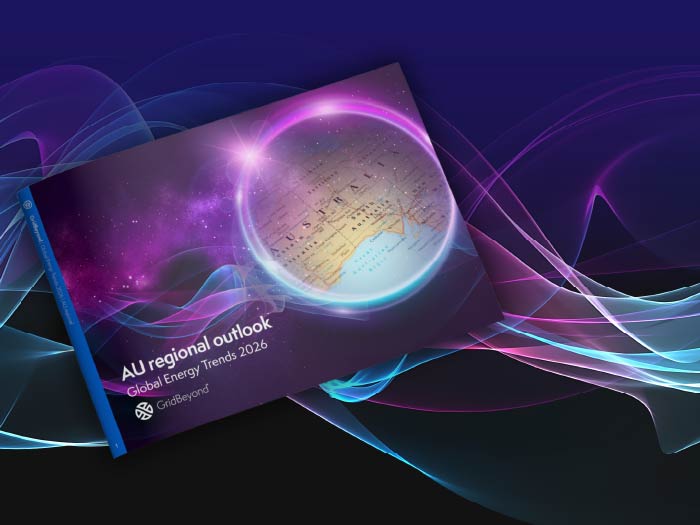News
better business decisions
Posted 1 year ago | 11 minute read

Demand side response (DSR): What is it? Why do it?
Ultimately, the ability to be flexible about when you use energy represents both a value and a cost and utility and grid demand response programs allow you to monetize that flexibility.
By participating in demand response programs your business could receive substantial financial payments for agreeing to reduce energy in response to grid signals. The payments earned from these programs can then be reinvested into energy efficiency measures, renewables or battery storage technologies that provide further flexibility to your site, reduce your operating costs and support the transition to a greener future.
Here we examine what demand response is, how it works, what benefits it delivers, and how it fits into a holistic energy management strategy.
What is energy flexibility?
In energy terms, flexibility is identifying the lowest and highest amounts of energy a site, generator, process or piece of equipment can consume or generate, and the ability to manage consumption or generation within these parameters.
When it comes to assets, equipment and machinery, most business plants can find energy flexibility, and therefore participate in demand response. These might include refrigeration, furnaces, fans, VSDs, conveyors, on-site energy storage, and many more.
What is demand response?
Demand side response is best understood through the context of the Grid’s requirements.
The electric Grid is responsible for maintaining the balance between electricity supply and electricity demand. Put more simply, the grid’s job is to ensure that the country is generating as much power as its consumers (commercial and domestic) are using. For this to happen, we need a grid frequency balanced at all times, with no more than 1% of variance either side of that. Either balanced at 50Hz or 60Hz depending on the grid.
Now, given our energy system’s increasing reliance on renewable energy sources such as wind and solar – whose outputs are cleaner but less predictable than traditional sources like coal and nuclear – this balance is becoming more difficult to maintain, which consequently increases the risk of blackouts and other electricity supply issues.
Practically speaking, electricity cannot be easily stored on a large scale. As a result, supply and demand for electricity must remain in a balance. When demand goes up (e.g., due to an increase in energy usage during a heat wave, or due to a decrease in supply when a transmission line goes down) utilities and grid operators have a few options:
• risk a blackout
• buy electricity on the open markets
• fire up peaking power plants
• dispatch demand response and pay large energy users to reduce consumption
Balancing the system is becoming ever more complicated as increased levels of intermittent renewable generation, like solar and wind farms, and large-scale battery storage systems start to impact our system.
Demand response is the blanket term for the management of consumer electricity demand, which typically unlocks financial incentives. For example, if an energy intensive business can reduce its energy consumption at times of peak demand on the grid, or at times of reduced renewable generation, the grid operator will reward the business for the amount they reduce. This can be by reducing the load used on site, or by switching to using embedded generation (such as combined heat and power) or drawing from energy storage (such as a behind-the-meter battery).
It is all about creating flexibility on the demand side of the energy market, so that the entire energy market is more resilient and more agile in times of real emergency. This provides businesses with an additional revenue stream and, when working with the right energy partner, reduces overall electricity costs too. The financial and operational benefits can be very significant.
Who DSR is suitable for
Typically, any facility that can reduce at least 100 kilowatts of electricity is a good candidate for demand response.
Examples may include schools and college campuses, hospitals and healthcare facilities, manufacturing facilities, food processing and cold storage facilities, commercial property buildings, grocery stores and retail malls, government buildings, and many more.
You also need to be willing to flex power consumption or generation quickly – within seconds – whenever the grid requires it, because the whole idea of DSR is that it gives immediate assistance to the grid, helping it to rebalance and prevent blackouts.
Your DSR technology is what enables these fast switches, and they happen automatically. This equipment, although often covered by the income from participation, is expensive to install, so you need a large operation in order for it to be viable and cost-effective for your business.
The benefits of demand side response
Earning revenue and saving costs
DSR presents a lucrative opportunity for all compatible businesses. Put simply, you will start to profit from existing assets that you have to use anyway. Without any effort on your part – apart from arranging the initial installation of your DSR platform – your organisation will earn easy ongoing revenue while simultaneously cutting energy costs.
The amounts you can earn through your DSR participation will depend on numerous factors, but your chosen DSR provider (or ‘aggregator’) should carry out an assessment on your assets and then provide a detailed forecast for you. To arrange an initial consultation or an assessment, contact us and we can talk you through the entire process.
Contributing to the balancing of the grid
In addition to the obvious monetary advantage of DSR, participating in it will also mean that your organisation is providing a benefit to wider society: you are actively, directly helping to stabilise the entire electricity supply – enabling industry to continue, keeping homes warm and light, and so on.
Let’s say you are participating in DSR while none of your competitors are. You are, perhaps ironically, helping to ensure that your competitors remain operational, but whose CSR profile is enhanced as a result?
What a DSR provider/aggregator does
A DSR provider’s job is to identify which of your assets are suitable for DSR, to define your response parameters, to install the necessary equipment and technology, and to then manage your ongoing participation.
A good provider will move you strategically between the different energy markets (the different DSR services) to ensure that you generate optimum revenue from your DSR participation, assigning you to the right markets at the right times.
Each market fluctuates depending on the grid’s needs and other technical factors, so your provider should be constantly monitoring these markets and making tweaks on your behalf, behind the scenes.
The key questions your DSR provider should be able to answer
- “How much will I get paid for my DSR participation?”
- “How often will I have to adjust my assets’ consumption?”
- “How long will I need to adjust for?”
- “Which energy markets can I utilise?”
- The different DSR services (‘markets’)
Types of demand response
There are 3 major categories of demand response products that utility or grid operators typically offer:
- capacity markets
- price-responsive markets
- ancillary services
Capacity markets
Capacity markets provide an additional incentive for developers of generating capacity (i.e., power plants or demand response providers) to make their capacity available to electric markets where price signals alone would not. In contrast, in energy-only electricity markets, like the one used in Texas (ERCOT), generators and demand response providers rely on energy market price spikes during periods of shortage.
Capacity markets essentially pay resources for being available to meet peak electricity demand. Providers are paid on a kilowatt per year basis for the capacity that a power plant can generate or, in the case of demand response, the capacity of power that can be reduced.

Ancillary services
Even in the best of circumstances, the grid will experience short term, temporary changes in overall capacity, e.g., when a power plant or transmission line goes out of service, or when there are inconsistencies in generation from more intermittent energy sources like wind or solar.
Ancillary services products address these short-term imbalances by dispatching resources within seconds or minutes. Demand response can act as an ancillary service that responds just as quickly as a power plant would, depending on the type of ancillary service required. Under ancillary service programs, energy users are paid to reduce demand to keep the grid operating within its usual frequency range.

Price-responsive markets
Prices are important, both to energy users and energy producers. The concept behind demand response is to provide the opportunity for consumers to voluntarily reduce their consumption when prices rise in the regional wholesale electricity market based on the wholesale electricity price, which fluctuates in response to supply and demand.
Businesses that have generation or energy storage assets can also dispatch these assets to capture spot market revenue when prices are high. These actions allow businesses to limit their overall energy spend when it is economically attractive to do so. Utilities benefit from the dip in peak demand that, in turn, limits the need to build new generation resources and upgrade to transmission lines.
How DSR affects your operations
Demand side response is supposed to work around your day-to-day operations, keeping you well within your operable range. As long as your assets are suitable and correctly configured, this will be the case and you will not experience any problems.
Noticeable interruptions are extremely rare, and they should only be mild inconveniences when they do occur. Typically, the longest you will be expected to adjust for is 30 minutes at a time, but extreme circumstances can require you to switch off for longer – up to four hours in an absolute worst-case scenario.
Your provider’s job is to figure out how they can move you between the different markets strategically, without any effort on your end. That is a key element of DSR that you should bear in mind: the provider should be using your DSR platform to do it all for you, while you concentrate on running your operations smoothly.
The risks of DSR
DSR is very low-risk rather than no-risk. The biggest worry companies have about DSR is the potential interruption to operations. However, noticeable disruption is rare. It is only in these times of emergency that your DSR participation will even be noticeable to you from an operational perspective – your provider should be working your DSR participation around your operations, rather than vice versa.
On top of that, you sometimes have to invest in DSR equipment and a DSR platform before you can start to participate in DSR. Once you are up and running, your provider then needs to start moving you between your chosen markets – effectively winning those DSR contracts on your behalf. Book some time in with our team to learn about our no-upfront-capex system and how it will help you avoid expensive outlays.
If your provider cannot win those contracts in the first place – for example, if you require higher prices than the markets are offering in order to make DSR cost-effective for your organisation – you will not participate and therefore will not get any return on that investment. In that sense, there is a low level of market risk involved in DSR.
However, a good provider would not allow you to get into that position in the first place. Before doing any sort of onboarding or installation, they would carry out a thorough assessment of your facility and your assets to determine whether DSR would indeed be cost-effective and operationally viable for you.
Demand response with GridBeyond
GridBeyond works on the basis of three key principles when integrating demand response and intelligent energy technology into an overall energy strategy. Reduce demand, increase generation and optimize energy use.
Connected assets benefit from automation of demand response events, and can further enhance operational efficiencies by providing analytics, benchmarking, machine learning and predictive maintenance.
Our AI-powered energy optimization software enables automated participation in the most valuable demand response programs and price-responsive markets and helps your business avoid peak electricity charges, integrating seamlessly with and enhancing the overall energy strategy.
By boosting energy performance and optimization with dynamic load shifting, scheduling, smart procurement, storage and embedded generation, an industrial site becomes financially and operationally more resilient.
The patterns emerging from asset-level data is used to improve on-site overall equipment effectiveness (OEE) and predictive maintenance by providing adequate visibility to take action and provides the automation, alerts and thresholds required before a key process fails.
The data gathered from a connected network of assets means highly accurate automation, as well as key insights for benchmarking and analytics.

For more information about DSR and how your organisation can start to benefit from it, read our detailed FAQs page or get in touch with us to set up a consultation.





